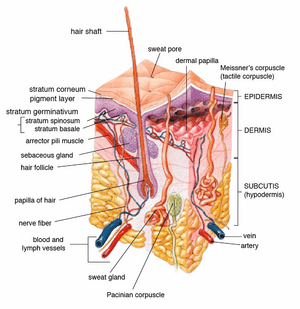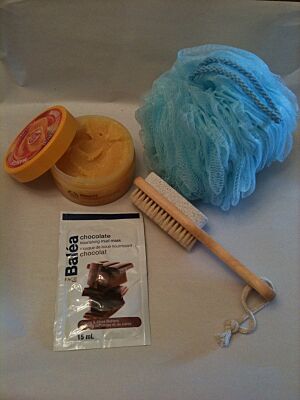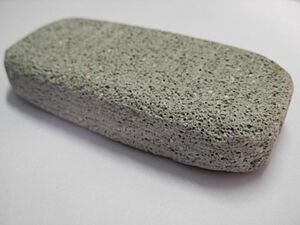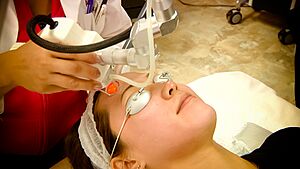Exfoliation (cosmetology) facts for kids
In cosmetology, exfoliation means removing dead skin cells and dirt from the surface of your skin. The word comes from a Latin term meaning 'to strip off leaves'. This is a common practice in beauty care. It helps your skin make new cells. It also gives your skin a deep clean. Exfoliation is often part of facials. You can do it using physical scrubbing or special chemicals. People use exfoliants to make their skin look more beautiful, young, and healthy.
Contents
History of Exfoliation
People first practiced exfoliation in ancient Egypt. It was also used in Asia, especially in China. This happened during the Qing Dynasty, which was from 1644 to 1944.
Mechanical Exfoliation: Scrubbing Your Skin
Mechanical exfoliation means you physically scrub your skin. You use a material that is a bit rough. Some examples of these exfoliants are:
- Microfiber cloths
- Special sticky sheets
- Scrubs with tiny beads
- Crushed apricot kernel or almond shells
- Sugar or salt crystals
- Pumice
- Sponges, loofahs, and brushes
Many facial scrubs are sold in stores. You can use them at home. If you have dry skin, you should avoid scrubs with a lot of pumice. Pumice is often used to exfoliate the skin on your feet.
Loofahs: Sponges from a Plant
Loofahs are shower tools. They are used for both cleaning and exfoliating your skin. Loofahs get their name from a plant called luffa. This plant is a type of gourd, like a cucumber.
When the luffa plant grows, its fibers dry out. The dried shell can then be used to make a spongy material. Makers remove the seeds and shape the gourd into a loofah.
Loofahs do more than just exfoliate. They help spread soap all over your body. They also help your blood flow better when you use them.
Loofahs have tiny holes. This means they can easily hold onto bacteria and fungi. These can cause infections. To keep your loofah clean:
- Rinse and dry it after every use.
- Soak it weekly in a mix of bleach and water.
- Replace your loofah every 3 to 4 weeks.
Exfoliation Nets: A West African Secret
Exfoliation nets are shower tools. They are made of nylon material. They look like knotted mesh nets. These nets are great for exfoliating and making soap foam.
Exfoliation nets come from Ghana. They are popular in many West African countries. Their shape and material help them dry faster than regular sponges. This means fewer bacteria can grow on them.
To care for your exfoliation net:
- Hang it to dry after each use.
- Clean it weekly in a washing machine or by hand.
Microbead Scrubs: Tiny Plastics, Big Problem
Microbead scrubs are beauty products. They have tiny plastic balls inside them. These balls help scrub away dead skin cells. These plastic beads were used instead of natural things. Natural exfoliants include pumice, oatmeal, and walnut shells. Microbeads are often made from a plastic called polyethylene terephthalate.
When you rub these scrubs on your skin, the beads polish it. They remove the top layer of dead skin. To use them, first soften your skin with warm water. Then, gently rub the scrub in circles. Finally, rinse it off.
These tiny plastic beads cause a lot of harm to the environment. They especially hurt ocean life. Because of this, many countries have banned them.
Pumice: A Volcanic Rock for Smooth Skin
Pumice is a type of rock. It forms when lava cools very quickly. Gas bubbles get trapped inside it. Pumice is a bit rough. This makes it good for exfoliating.
You can use a pumice stone to remove dead skin cells. It works well on hard skin spots. These are often found on your feet, like calluses or corns.
To use a pumice stone:
- Soak the rough skin area in warm water. Do this until the skin feels soft.
- Wet the pumice stone.
- Rub the stone on the area with medium pressure. Do this for about 2 to 3 minutes.
Dermaplaning: Gentle Blade Exfoliation
Dermaplaning uses a single razor blade. It looks like a small scalpel. This blade is called a dermatome. A professional gently moves it across the skin on your face. This removes the top layer of dead skin cells. It also removes tiny, soft hairs called "peach fuzz."
This process helps your skin soak up products better. It also makes your skin feel smoother. Dermaplaning does not help your skin make more collagen.
Some people think that the "peach fuzz" will grow back thicker or darker. This is not true. Specialists say that removing these hairs does not change how they grow. It also does not change their color or texture.
An aesthetician should usually do this procedure. The blade is often used on clean, dry skin. It covers your forehead, cheeks, chin, nose, and neck. Sometimes, it can also be done on skin with oil on it.
Hair Removal: An Unexpected Exfoliant
Some ways of hair removal also exfoliate your skin.
Waxing pulls hair out of your skin. This also removes dead skin cells. You can wax every two to eight weeks. But it is not as frequent as other exfoliants. So, it does not fully replace a regular exfoliation routine.
Wet shaving also has exfoliating benefits. When you glide a shaving brush on your face, it removes dead skin. It also cleanses your skin. After applying shaving cream, the razor removes more dead skin. This is because it shaves very close to your skin. Manual razors exfoliate better than electric razors.
Chemical Exfoliation: Using Special Liquids
Chemical exfoliation uses special liquids. These liquids remove dead skin cells from your face.
History of Chemical Exfoliation
Ancient Egyptians used chemical exfoliation. They mixed animal oils, alabaster, salt, and sour milk. This helped improve their skin. Other civilizations also developed chemical exfoliation. These included Greek, Roman, Turkish, Indian, and Hungarian people.
In 1871, Tilbury Fox developed a method. He used phenol peeling to reduce freckles. This method then became more popular.
How Chemical Exfoliation Works
Chemical exfoliants contain different types of acids or enzymes. These chemicals weaken the "glue" that holds skin cells together. This allows the dead cells to easily fall off.
Some common types include:
- Alpha-hydroxy acids (AHAs): Like glycolic acid or lactic acid. These clear the outer layer of skin.
- Beta hydroxy acids (BHAs): Like salicylic acid. These go deeper to clean skin from the inside.
- Polyhydroxy acids (PHAs): Like lactobionic acid.
You can find AHAs and BHAs in products for daily use. Doctors or skin care professionals can apply stronger versions. This type of exfoliation is good for people with acne.
Some products for hair removal also exfoliate. These are called chemical depilatorys, like Nair. They contain chemicals like calcium hydroxide. They are used more often than waxing, about once a week. They can act as a weekly exfoliant.
Technological Exfoliation: Advanced Methods
New technologies in beauty care offer advanced ways to exfoliate. One example is laser resurfacing.
Ablative Laser Resurfacing: Using Light for Skin Renewal
This process uses a laser to treat skin flaws. It is often used to make faces look younger. This method works best for wrinkles and uneven skin color. Lasers like carbon dioxide lasers are used.
The laser removes the top outer layer of skin. At the same time, it heats the skin underneath. This helps your skin make more collagen. Collagen makes your skin feel firmer and smoother. The top layer of skin then heals and grows back. This reveals smoother and tighter skin.
Newer versions of these lasers are called fractional lasers. They leave small parts of skin untreated. This helps the skin heal faster. It also causes fewer side effects.
Ablative laser resurfacing has some risks. These can include:
- Redness and swelling
- Itching or pain
- Acne or infection
- Changes in skin color
- Scarring
You should talk to a doctor before having this procedure. They can tell you if it is right for you.
Dermabrasion: Smoothing Skin with a Rotating Tool
Dermabrasion helps reduce skin flaws on your face. These can be lines, wrinkles, scars, or discoloration. In this process, a fast-spinning tool removes the outermost layer of facial skin.
Dermabrasion requires anesthetics. These numb your skin before the procedure. Depending on how much skin is treated, you might get more numbing medicine. This helps limit any pain.
Dermabrasion also has some risks. These can include:
- Redness and swelling
- Acne or enlarged pores
- Changes in skin color
- Infection or scarring
- Rashes
After dermabrasion, your skin will often be sensitive. It might have red spots or discoloration for several weeks.
Disadvantages of Exfoliation
Skin doctors say that chemical or manual exfoliation is not always needed. Your dead skin cells naturally fall off on their own.
Too much artificial exfoliation can harm your skin's protective barrier. This barrier helps protect your skin from germs. If it is damaged, you could get an infection. Your skin might also feel tight and sensitive.
Exfoliating too much can make dry, flaky skin worse. Dry skin needs moisture to heal. Exfoliation can also cause some redness at first.
Microbeads: A Threat to Our Oceans
Microbeads are tiny plastic particles. They are used in some mechanical exfoliants. These beads are very small, less than 1 millimeter. They are too tiny for sewage works to catch. So, many microbeads end up in the environment. They cause harm to ocean ecosystems.
Because of this, in June 2014, Illinois was the first U.S. state to ban microbeads. Many beauty companies, like L'Oreal and Johnson & Johnson, agreed to use more natural ingredients instead.
See also
- Chemical peel
- Debridement
- Exfoliating towel
- Medical spa
- Microdermabrasion





